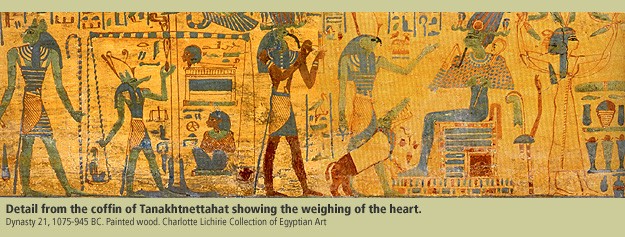In accordance with the Heliopolis creation myth, Atum was the first god to exist. The god, lonely, then decided to create the god Shu and the goddess Tefnut. The union of these two gods resulted in the birth of gods Geb and Nut. Finally, the children of Geb and Nut were Osiris, Set, Isis, and Nephthys.1
Osiris was the first ruler in Egyptian history, and he brought civilization to the land. Because of Osiris, agriculture, laws, religious institutions, and culture were given to the people of Egypt. During his reign was a time of prosperity for the ancient Egyptians. People were happy and so were the gods, except his brother Set. Set grew jealous, and resentful of Osiris’ success. Soon he began to plot his brother’s demise.2

Set threw a lavish and delicious banquet for his brother and his constituents. During the party, Set stood up and brought out a beautiful coffin, and announced a game. He told everyone at the feast that the person who could fit in the coffin could keep it. Unknown to the party attendees, Set had the coffin made to his brother’s exact measurements. One by one each of the guests attempted to fit into the coffin but were unsuccessful. Many tried to squeeze and shove themselves inside the carved box, but no one could fit comfortably inside the coffin. Finally, Osiris stood up to take his turn. As Osiris climbed into the box, Set seized the opportunity he had been plotting for. He shut and sealed the coffin with Osiris inside, and threw it into the Nile River. The river waters rushed Osiris’ living body out to sea, before finally resting in a tamarisk tree that was growing on the banks near Byblos in Phoenicia. Osiris, unable to break the seal on the coffin, struggled and fought for his life before dying in the very device intended to bury him.3
Isis, his wife and sister, was distraught by the events that transpired at Set’s feast. She decided that she would not rest until her husband’s body was found. Eventually, Isis succeeded in finding and retrieving Osiris’ body, and brought it back to Egypt. Once Isis and Osiris’ body were safely back in their homeland, the goddess then looked for a way to resurrect her beloved husband. As Isis searched for a solution, Set heard about his brother’s return. Set knew he had to act quickly, in order to make sure his plan for Osiris’ demise remained successful. Set found his brother’s body and cut it up into many pieces, and scattered them all over Egypt. Isis, upset about Set’s jealousy and interference, went on an expedition to find her husband, every piece of him. The goddess managed to retrieve all of Osiris’ body parts, except for one, to continue with her plan of revival. Isis was unable to find her husband’s penis, because it had been eaten by an oxyrhyncus fish. Regardless, Isis still managed to bring her husband back to life. During the resurrection, despite Osiris missing his genitalia, the god Horus was conceived during this time. Although Osiris was now alive and had co-created a son with his wife, he was still incomplete. Because of his missing body part he was unable to rule the land of the living. So Osiris was crowned the ruler of the Underworld.4

The word Osiris comes from the Egyptian word “Wsir.” This word can be translated to ‘powerful’ or ‘mighty’ in English.5 His job as ruler of the Underworld is to judge each Egyptian soul to determine their eligibility for the afterlife. In Egyptian art, the ruler of the Underworld is shown as being wrapped up from the chest downwards in mummy bandages. Another important feature of Osiris’ is his skin color, which is either green or black. He is typically these colors because green represents the color of rebirth and black symbolizes the color of fertility of the Nile Valley.6

Osiris judges the dead by weighing their hearts against a feather. If your heart is light, then you are allowed to pass into the Land of Two Fields. There are three requirements for entering the afterlife. First, your name had to be written down. Second, you had to have a preserved body and a tomb. Lastly, during your life you had to perform good deeds so your heart would be light enough to pass the weighing test when you met Anubis or Osiris in the underworld. The first two criteria were to insure that Ba and Ka, the two parts of ones soul, would be able to find its body each night to rest. The Ba was ones personality, and each day it would go and watch over ones family members in the land of the living. While ones Ka was a life force, it was unique to each person, and it would go each day to indulge in the Land of the Two Fields. If one lacked a written name on ones tomb or a preserved body then ones Ba and Ka would get lost and have no place to rest each night.7
- Don Nardo, Egyptian mythology (Detroit: Lucent Books an imprint of Gale, Cengage Learning, 2013), 48. ↵
- Don Nardo, Egyptian mythology (Detroit: Lucent Books an imprint of Gale, Cengage Learning, 2013), 49. ↵
- Don Nardo, Egyptian mythology (Detroit: Lucent Books an imprint of Gale, Cengage Learning, 2013), 50. ↵
- Don Nardo, Egyptian mythology (Detroit: Lucent Books an imprint of Gale, Cengage Learning, 2013), 52-53. ↵
- Salem Press Encyclopedia, January 2016, s.v. “Egyptian mythology,” by Shari P. Miller. ↵
- Robert A. Armour, Gods and Myths of Ancient Egypt (New York: American University in Cairo Press, 2001), 73, 141, 177. ↵
- Anthony Spalinger, “The Limitations of Formal Ancient Egyptian Religion,” Journal of Near Eastern Studies, no. 4 (1998): 241. ↵



94 comments
Johnanthony Hernandez
I’ve always been interested in reading the lore behind ancient religions and how their gods and goddess came to hold their position of power. While the gods of Egypt never really peeked my interest, your article makes me want to read more into Egyptian myths and into the aspects of the other gods and goddess. I did find it interesting that you referred to Osiris’s brother as Set and not the more common Seth.
Auroara-Juhl Nikkels
I love reading about Egyptian mythology! You’re article was pretty interesting to read, though some events were hard to tell apart. It is interesting to me how Osiris came to be ruler of the underworld, compared to how, say Hades, came to be ruler. But again there are always parallels in mythologies. Set cut up his brother and scattered his remain and in Greek mythology, Kronos’ children cup him up.
Edgar Ramon
I had heard of the Egyptian god Osiris, yet had never read up on him. It is also interesting to better my understanding of why the ancient Egyptians practiced mummification. The Ba and Ka explanation makes sense. However this article made me wonder what importance the gods Shu, Tefnut, Geb, Nut and Nepthys have. And this is because the article made me want to learn more about the Egyptian myths.
Erin Vento
I love reading about Gods and Goddesses, but I had very minimal knowledge on the Egyptian Gods and never heard that story about Osiris and Set or that Osiris had a whole backstory to being ruler of the Underworld. The story almost reminded me of the story about Cain and Abel. Overall though, the article was extremely interesting and engaging.